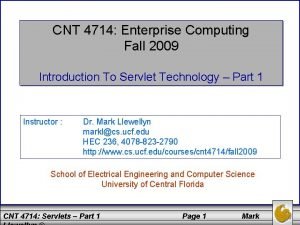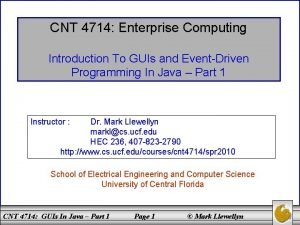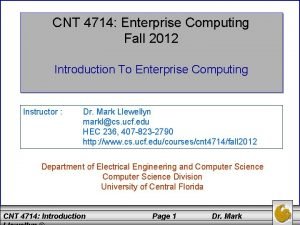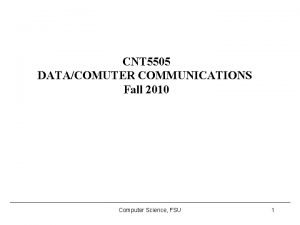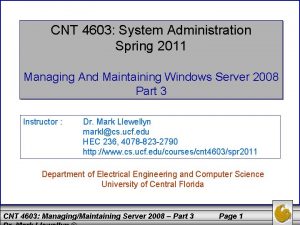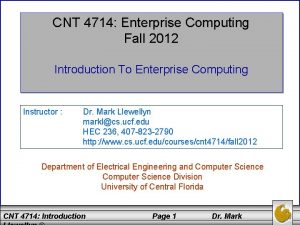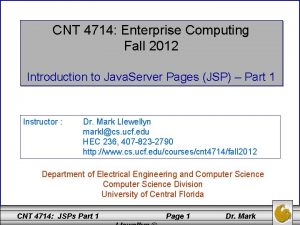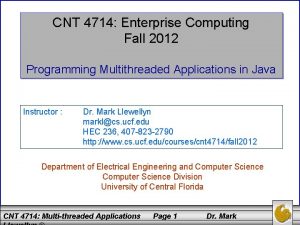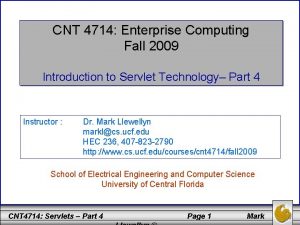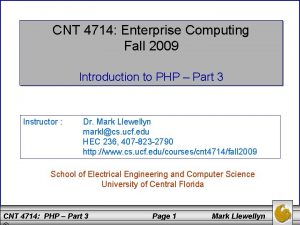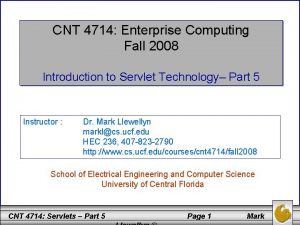CNT 4714 Enterprise Computing Fall 2012 Introduction To








- Slides: 8

CNT 4714: Enterprise Computing Fall 2012 Introduction To Enterprise Computing Instructor : Dr. Mark Llewellyn markl@cs. ucf. edu HEC 236, 407 -823 -2790 http: //www. cs. ucf. edu/courses/cnt 4714/fall 2012 Department of Electrical Engineering and Computer Science Division University of Central Florida CNT 4714: Introduction Page 1 Dr. Mark

Introduction to Enterprise Computing • In earlier times, computing servers were used “in-house” by a company’s employees on an intranet in order to accomplish the operations of the business. • Today the vast majority of companies are on the Internet in some fashion. • Not only do the company’s employees access the company’s website, but so too do customers, distributors, vendors, and anyone can access the site. • Companies have been forced to move from a local client/server or mainframe computing environment into a new world of multi-tier computing. CNT 4714: Introduction Page 2 Dr. Mark

Introduction to Enterprise Computing • This brings about a new set of challenges that must be handled in an efficient manner. • These challenges include reliability, scalability, security, application development, transaction processing, web interface development, and timely software development. • Companies need robust technologies and tools to develop enterprise software. • Enterprise computing, an umbrella term used primarily to sell business systems development products, traditionally refers to the mission-critical systems on which a business depends. • It almost always includes one or more databases. CNT 4714: Introduction Page 3 Dr. Mark

Introduction to Enterprise Computing • An enterprise solution identifies common problem domains within a business and provides a shared infrastructure as a solution for those identified problems. – • As an example, consider a banking enterprise which has locations in several different places around the world. The differences in the cultures and locations should not in any way obscure the common ground realities of customers and accounts. Looking at a business from an enterprise perspective means abstracting away the irrelevant differences in the way individual business components function and approach the business solutions from their common points. CNT 4714: Introduction Page 4 Dr. Mark

Introduction to Enterprise Computing • Applying this view to the design and development of software, an enterprise system provides the proper abstractions for business concepts that remain constant across a business so that they can be shared by all the different components or units within the company. • This includes sharing business concepts with vendors, clients, and perspective clients apart from the company itself. CNT 4714: Introduction Page 5 Dr. Mark

Requirements For Enterprise Systems 1. An enterprise system must avoid incorporating proprietary components, that is, it must be platform- and databaseindependent. Business should not impose any sort of technical requirements on vendors, clients and customers. Also it helps to integrate new components into the system as technology evolves as days go by. It is not possible to integrate new technological advancements into closed, proprietary components. CNT 4714: Introduction Page 6 Dr. Mark

Requirements For Enterprise Systems 2. An enterprise system must be capable of supporting a personalized user experience that is being made possible in many forms, such as, internationalization, localization, accessibility, personalization and customization. These requirements become feasible by designing user interfaces which can display content tailored to the language and cultural norms of the user interacting with the system. This also means that developing client side supporting tools will enable users with disabilities to access software applications. Finally, an enterprise system needs to be able to study the way users interact with it so that it can better support each user's unique mode of interaction. CNT 4714: Introduction Page 7 Dr. Mark

Requirements For Enterprise Systems 3. An enterprise system must be the authoritative, shared source for the business concepts it represents. All applications using concepts common across the business should reference the objects that represent those concepts from the shared system. This means that any given concept has an authoritative location that is transparent to the client from which it can be referenced. CNT 4714: Introduction Page 8 Dr. Mark
